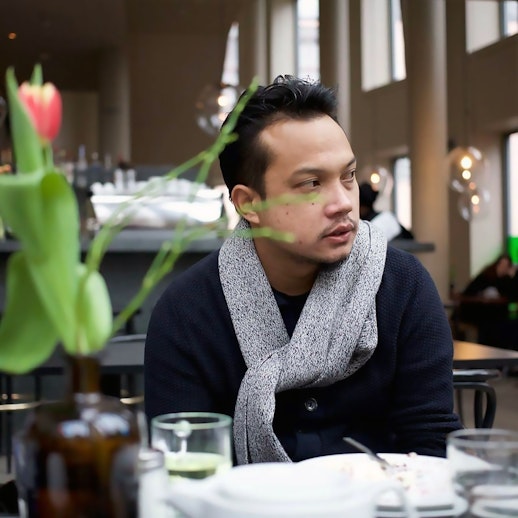A Co-creation Project: Usungan, a childhood dream and memory
Mohamad Faizuan Bin Mat
The year was 1994. We were having a big celebration for the annual khatamal Al-Quran parade in my little hometown of Kabong in Malaysia. I was one of the 30 participating kids who were carried around the parade in an usungan, also known as a palanquin structure consisting of a chair mounted between two poles—generally used to carry a person of status. In the coastal area of Sarawak, including Belawai and Kabong, usungan parades are held to celebrate newly-married couples during their wedding days and primary school children age from seven to 12 who have completed their Quranic studies. This customary practice has been around since the olden days and is a much-anticipated event among the local community. A variety of usungan designs are used to parade the ‘graduates’ along the main road of the village, including aeroplanes, cars, motorbikes, flowers, fishes, and even a replica of a mosque. The designs were requested by us—the participants—and our families had to fulfil our requests.
My beloved father was a fisherman, so the image of him going in and out of the sea every day has left a deep influence on our lives. Therefore, the fishing boat became the image for my personal usungan, which my family prepared for me as a gift for completing my studies. The excitement of my 12-year-old self—being celebrated and paraded around the kampong on my usungan, like a champion—was more than words could ever describe. It is indeed one of my most sweet and cherished memories.
The general functions of a palanquin include carrying goods or a sick or injured person. In Malaysian history, the usungan was originally made to carry and glorify the sultans. Palanquins exist in the history of most countries: for example, the earliest mention of a palanquin was recorded in the Ramayana, in approximately 250 BC in India. In Pahang, during the reign of Sultan Ahmad Al-Mu’adzam Shah (1881-1909). Back then, people used rivers as the main ‘highway’ to navigate from one place to another, but his method meant it was difficult to bring along horses or palanquins inside boats. Therefore the village chief of a kampong would prepare an usungan for people who have reached the destination, which will then be carried by two to six men as a vehicle for the sultan to go around their kampong.
However, the use of the usungan in Pahang was only popular up until the Sultan Abdullah Al Mu’tassim Billah (1917-1932) ruling era. The practice completely stopped during the reign of Sultan Abu Bakar Ri’ayatuddin Al-Mu’adzam Shah (1932-1974) due to urbanisation, modernisation and the invention of cars. However, in the coastal community of Sarawak in Malaysian Borneo, commoners still utilise the usungan for events and celebrations. The usungan practice at wedding days continues until today, but with a happy twist: the bridal usungan is filled with beautiful wedding decorations and accessories, such as the sirih junjung (betel leaves flower bouquet) and yellow glutinous rice.
Co-creation process of the usungan
My first-hand experience as a participant of the usungan parade has made me realise the potential of developing the experience into the context of contemporary art. The usungan parade became my case study to highlight the concept of co-creation. It is generally understood as a joint effort with experts and important parties such as consumers, communities, providers and others to build new values. This included concept, problem-solving, product and services. Co-creation is also a form of innovative collaboration, whereby the collaborative project is shared and developed together. This method was fulfilled by the villagers of Kabong while working together regardless of family or neighbours.
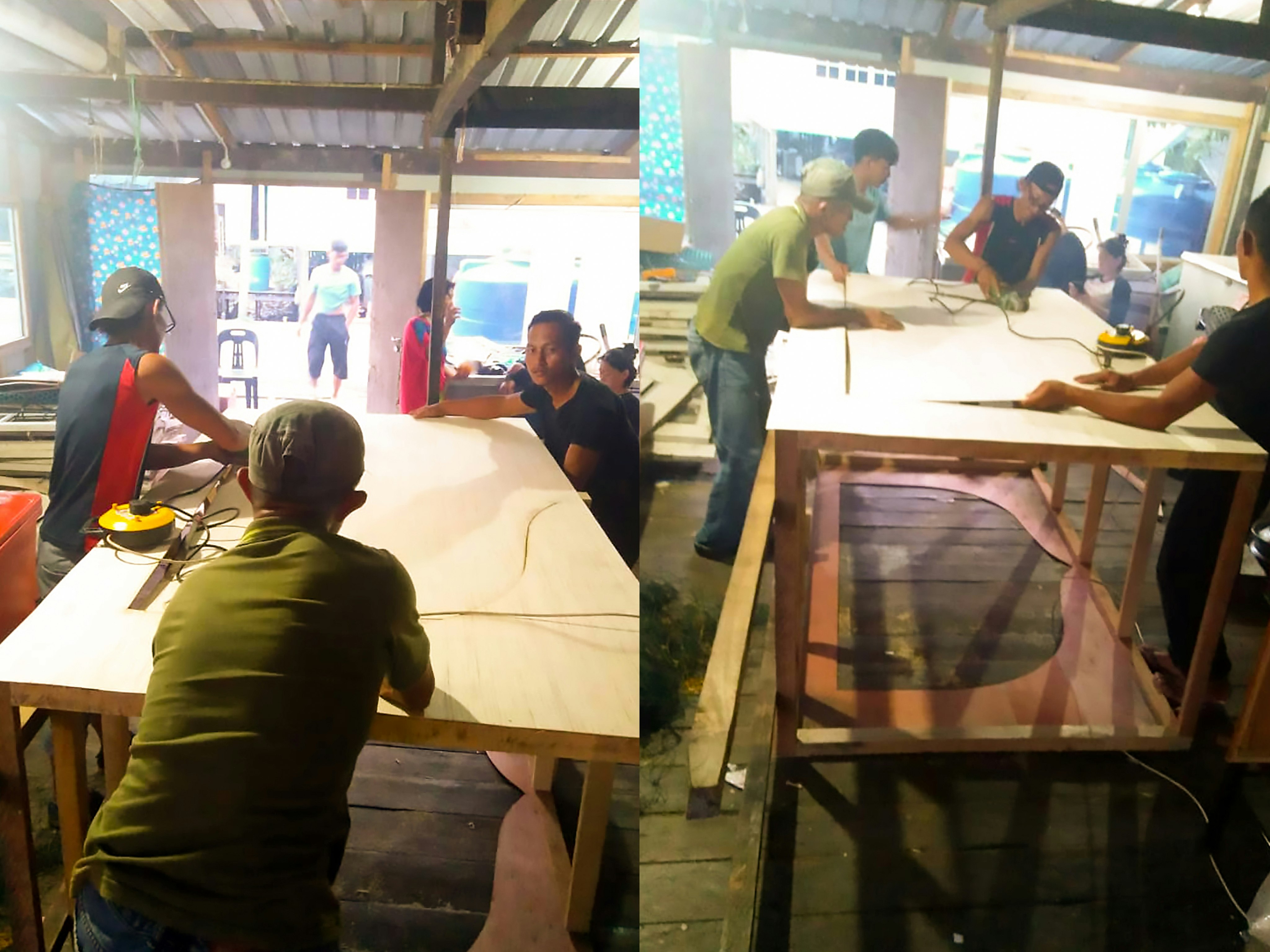
The making of the unsungan and co-creation, 2018; image: courtesy Mohamad Faizuan Bin Mat
The co-creation method in this case study requires all parties to be actively involved in the art-making process. Therefore, we selected a few participating families in Kabong to assist in the making of the usungan. Through a preliminary study, we have found out that there were no initial drawings or idea development process involved in the usual way of building an usungan structure, as the process started right away into production. I had brought a few of my good friends that consisted of fellow artists, designers, photographers, and videographers to take part in the making of the usungan together. Apart from recording the entire process— from usungan making to the parade—our main objectives also include providing guidance to the locals in constructing initial drawings, as well as giving advice on the materials selection. The purpose was to ensure that the assembled structure would not become too heavy when lifted. The co-creation process was divided into two phases: The first phase—‘the making’—took place from 19–25 November 2018; and the second phase—‘the reflection’—happened from 10-15 March 2019. The second phase was largely focused on getting feedback from the villagers on the concept of co-creation, which involved the joy of collaboration, bonding, and knowledge sharing.
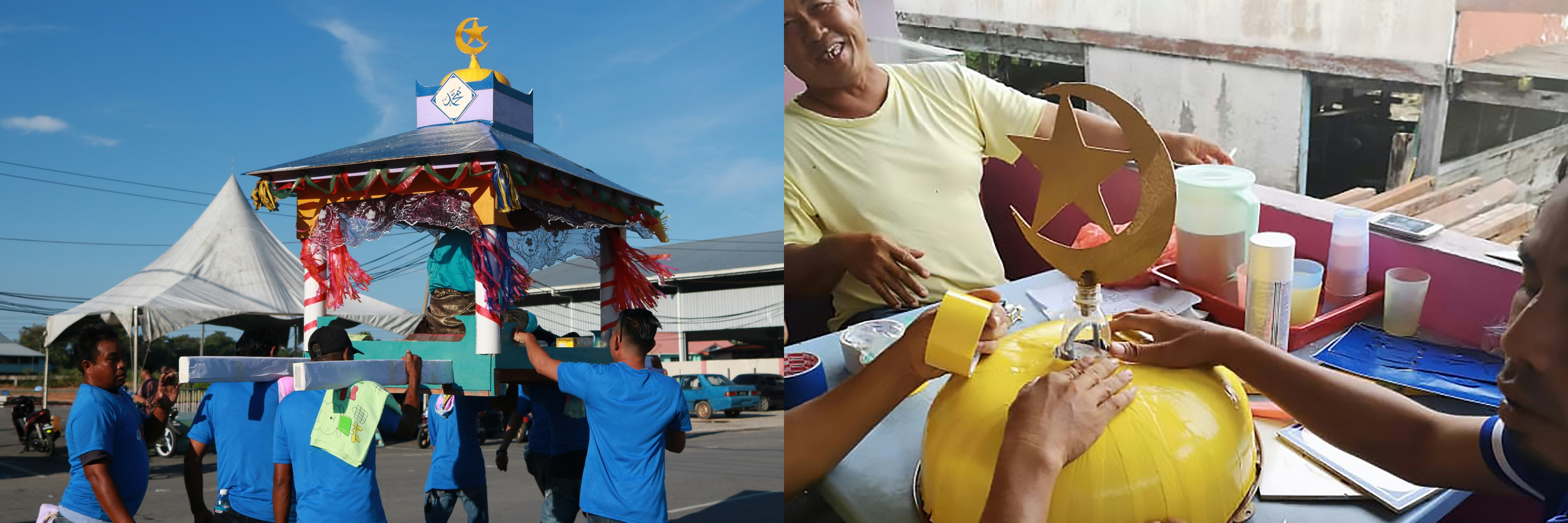
The process of building the dome, 2018; image: courtesy Mohamad Faizuan Bin Mat
The khatamal Al-Quran event that was held on 24 Nov 2018 had brought about a total of 88 participants. More than 20 usungan in different designs were created to carry the participants from the village mosque to the community hall accompanied by kompang (traditional Malay drums ensemble) and hadrah (a form of group singing, with lyrics that glorifies Allah, usually performed in religious events by the villagers). The community hall was used as the main event venue, where each participant will be reciting selected chapters from the Al-Quran. However, the usungan is not a compulsory requirement for the participants of khatamal Al-Quran; instead it was provided willingly by the families of the participants. There were also several participants who walked in the parade.
The usungan parade practice displays a strong community spirit among the local residents. Each usungan will be carried by four to eight people, according to size and weight of the structure. Although most of the participants have their usungan created by their own family members, there are some cases where two families agree to help each other by building the usungan for their children. Both parties would willingly contribute in terms of financial, manpower and innovation to complete their usungan. As for the usungan bearers, it was done on a voluntary basis without expecting any payment. Instead, these kind volunteers will be gifted a handkerchief for their hard work.
According to local sources, there were more than 100 designs of the usungan paraded in Kabong for the 2017 khatamal Al-Quran event. Various designs of the usungan that were created indicate the creative and innovative minds of the coastal Sarawak Malay community. The residents of Kabong believe that this customary practice inherited from their ancestors has already been in existence for more than 100 years. For that reason, a sense of love and the desire to maintain the tradition is strong among the communities.
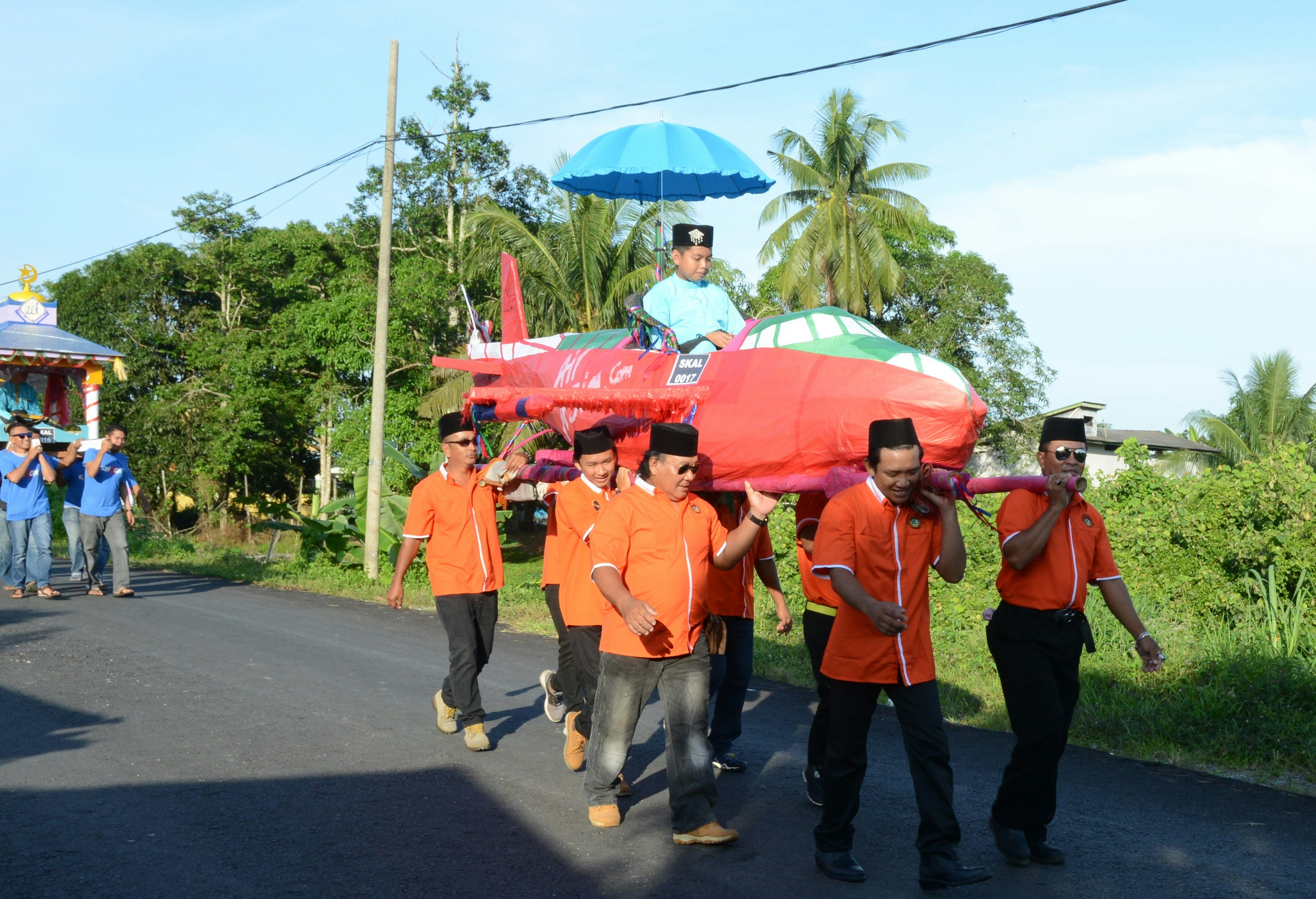
An usungan aircraft design created to reflect a childhood dream, 2018, photograph, image: courtesy Mohamad Faizuan Bin Mat
The Making of the Usungan
The subject or design of an usungan is usually created according to the wishes of each celebrated participant. As we have come to understand, these are a result of things or matters that are close to the child, such as the occupation of the parents. Every child’s desires also come from what is absorbed from their surroundings and is driven by their personal ambitions, with many designs representing an expression of their creative thoughts and imaginations. For example, a child who wishes to be a pilot someday will request an aircraft design for his usungan. We could tell that his subject of choice for his personal usungan is a reflection of his ambition. After expressing his wishes, his parents and family will do their very best to make an usungan aircraft to fulfil their child’s wish.
Interestingly, the subject matter of the shark boat has become an all-time favourite usungan design among the community. This is due to the geographical factor and the everyday life of the people in Kabong, which results in most of the residents working as fishermen. Not surprisingly, usungan boats can often be seen in these parades.
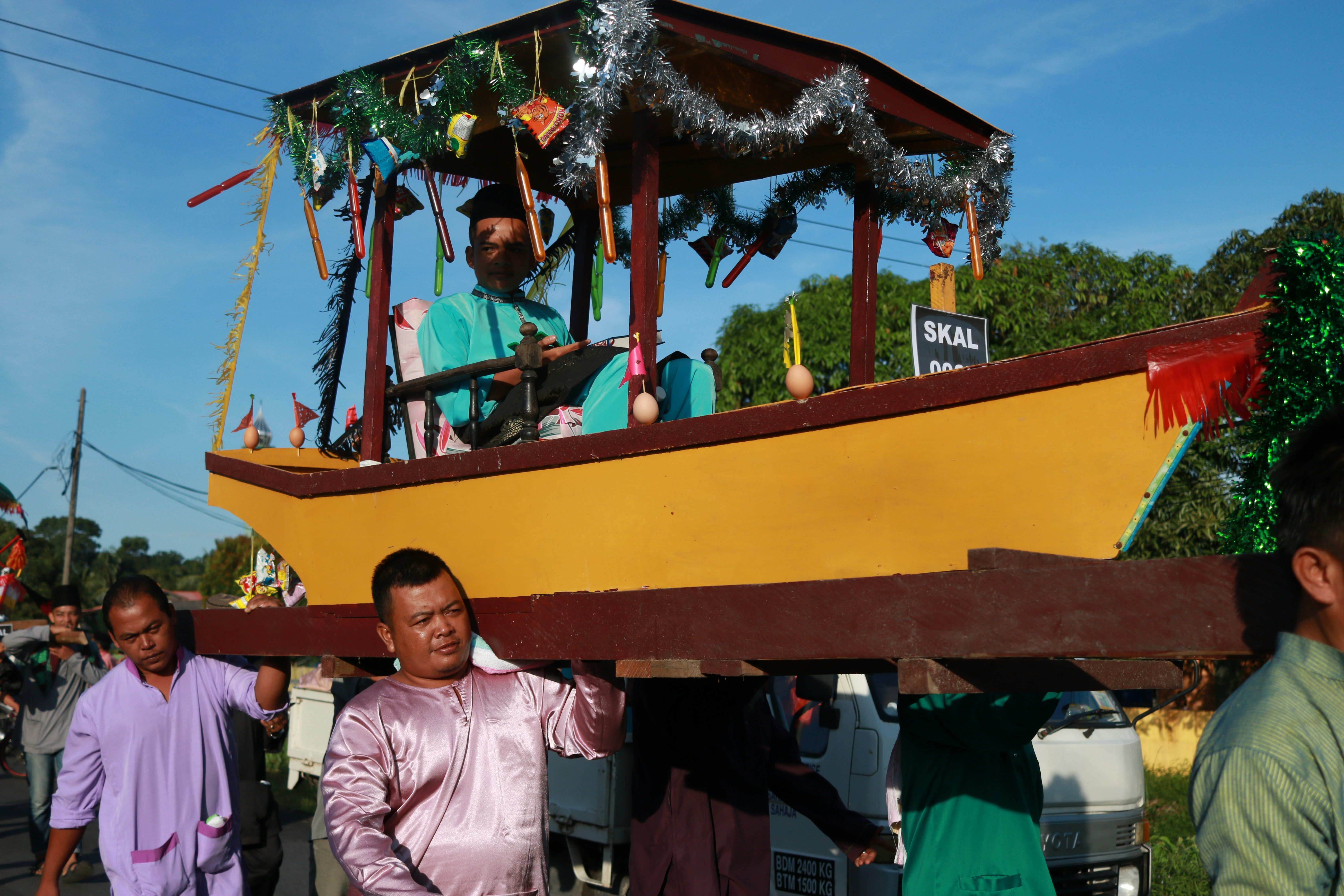
Boat as a subject-matter to produce usungan, 2018; image: courtesy Mohamad Faizuan Bin Mat
It’s the intention that every child’s wish and desire is fulfilled as a gift for completing their Quranic studies. As their wishes are granted, these children would also promise to continue doing their best to achieve success in school, or in any field that they would venture into in the future. The usungan practice somehow serves as a platform to nurture self-motivation and the desire to continue reaching for success in the world and hereafter.
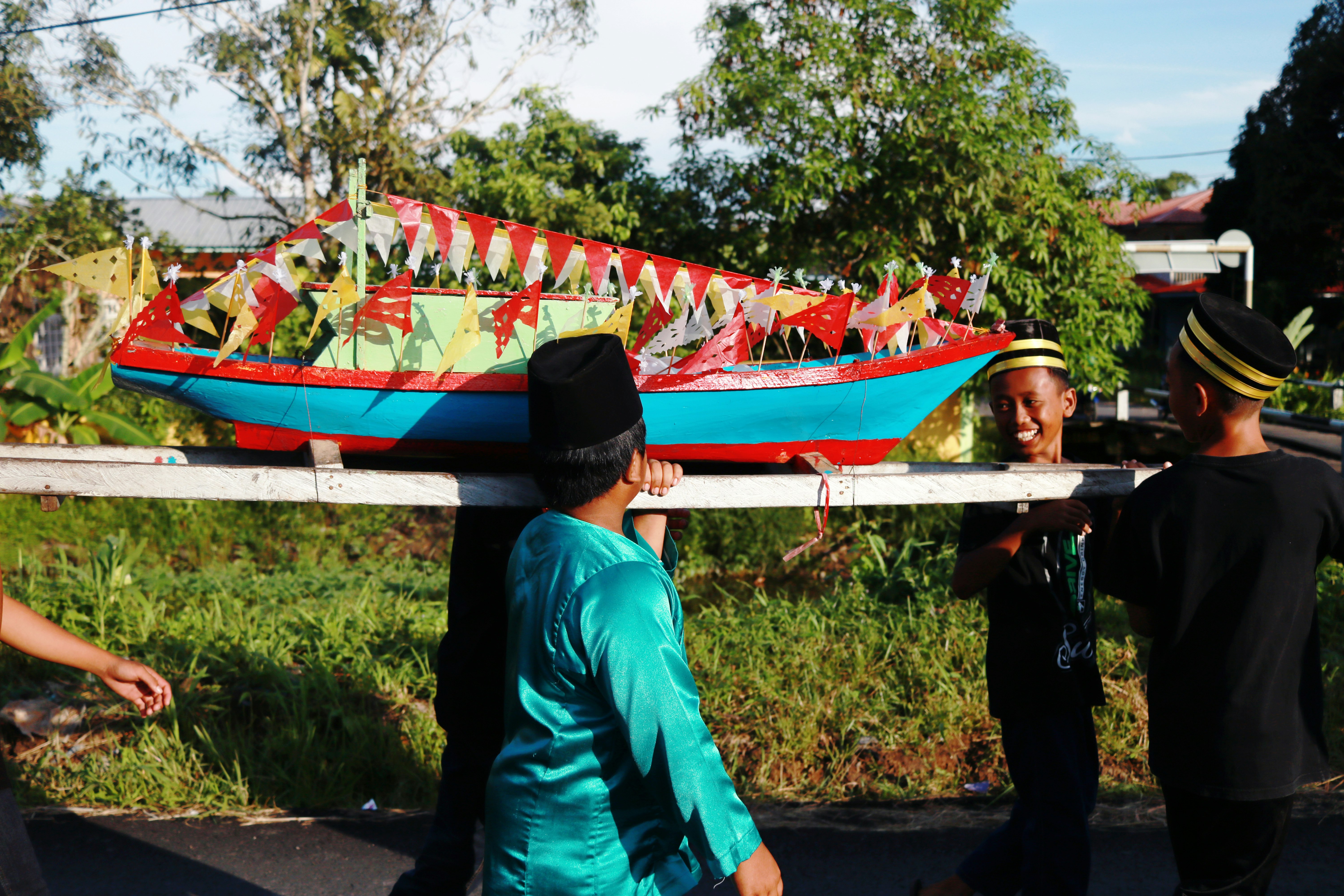
A small replica of an unsungan (or a jong) made for children to lift in the khatamal Al-Quaran event, 2018; image: courtesy Mohamad Faizuan Bin Mat
The jong is a type of sculpture or replica that is similar to the usungan, albeit smaller in size. During the usungan parade, it is carried by children who are not the participants of the khatamal Al-Quran event. The word jong refers to raft or boat by the native Malays of Kabong and it is used to carry the yellow glutinous rice and bunga telur (flower-decorated boiled eggs) as a gift to the religious teachers of the khatamal Al-Quran participants. At the end of each event, the children in charge of bearing the jong would deliver the gifts to religious teachers at their respective houses. It’s a symbolic gesture of appreciation towards their much-respected teachers. The jong would then be returned to its owner, who is also coincidentally the father of one of the participants. This practice also helps to encourage the younger generations to volunteer in the usungan parade in the future.
The image above shows a type of jong that has been used for more than 20 years. It is a prized inheritance used by family and closed relatives. However, the jong parade practice is diminishing due to damages on the jong caused by prolonged use. Many also opt to deliver the gifts straight to their religious teachers’ doorstep. Furthermore, the price of making one jong can be extremely costly if the owner chooses to use high-quality wood or logs that last long. Every jong that was made cost about MYR500-MYR1000 (AUD $170-340) depending on the quality of the materials.
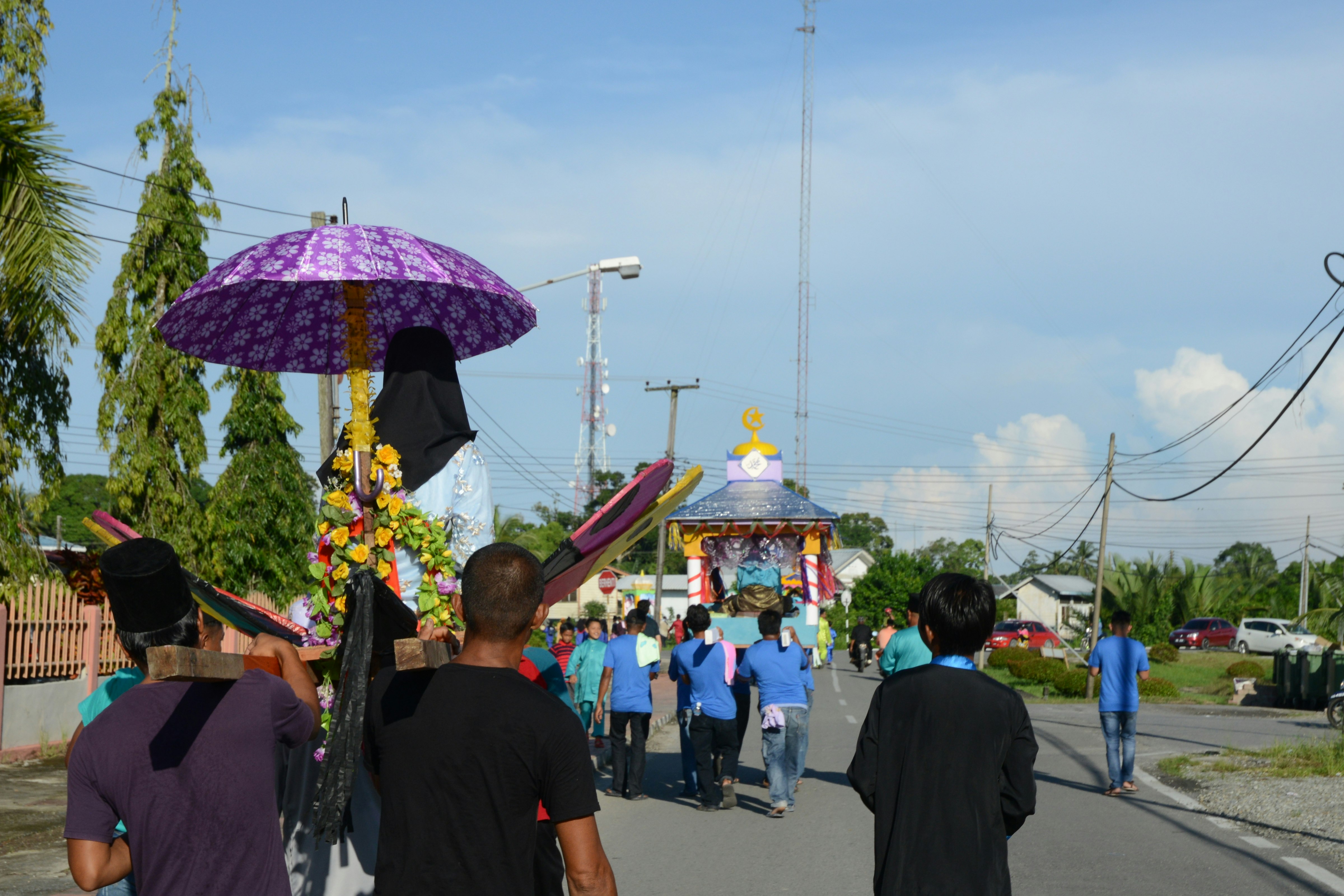
Various usungans in the khatamal Al-Quaran parade, 2018; image: courtesy Mohamad Faizuan Bin Mat
The usungan in Contemporary Spaces
How do we bring the traditional usungan into a contemporary space? I have seen several definitions pertaining to the term ‘co-creation’ whereby the meaning does not have much difference to ‘Socially-Engaged Art’. Both terms emphasise the social changes through collaborations with the community, individuals and institutions in the context of participatory art. It values the process of art making more compared to the final outcome. However, it is not widely practiced in Malaysia. Hence, more recorded studies on co-creation are needed to sustain the knowledge development of this method in a local context. Although the usungan practice has been around for a long time, it remained unrecorded until our research took place. Without realisation, the traditional practice has somehow provided a work process that leads to co-creation.
In the case study of usungan, there were a number of things that we have done, including assisting the locals in documenting the designs of usungan, helping them with the early sketches and drawings, giving financial assistance to the families, and providing advice in the materials selection. Ultimately, the most crucial part in this practice is getting the local communities to work together to deliver the final outcome. My fellow artists, researchers, and I have created the artwork The Parade of Usungan (2019) that highlights the concept of co-creation, based on our own experience in the case study of Kabong’s usungan parade.
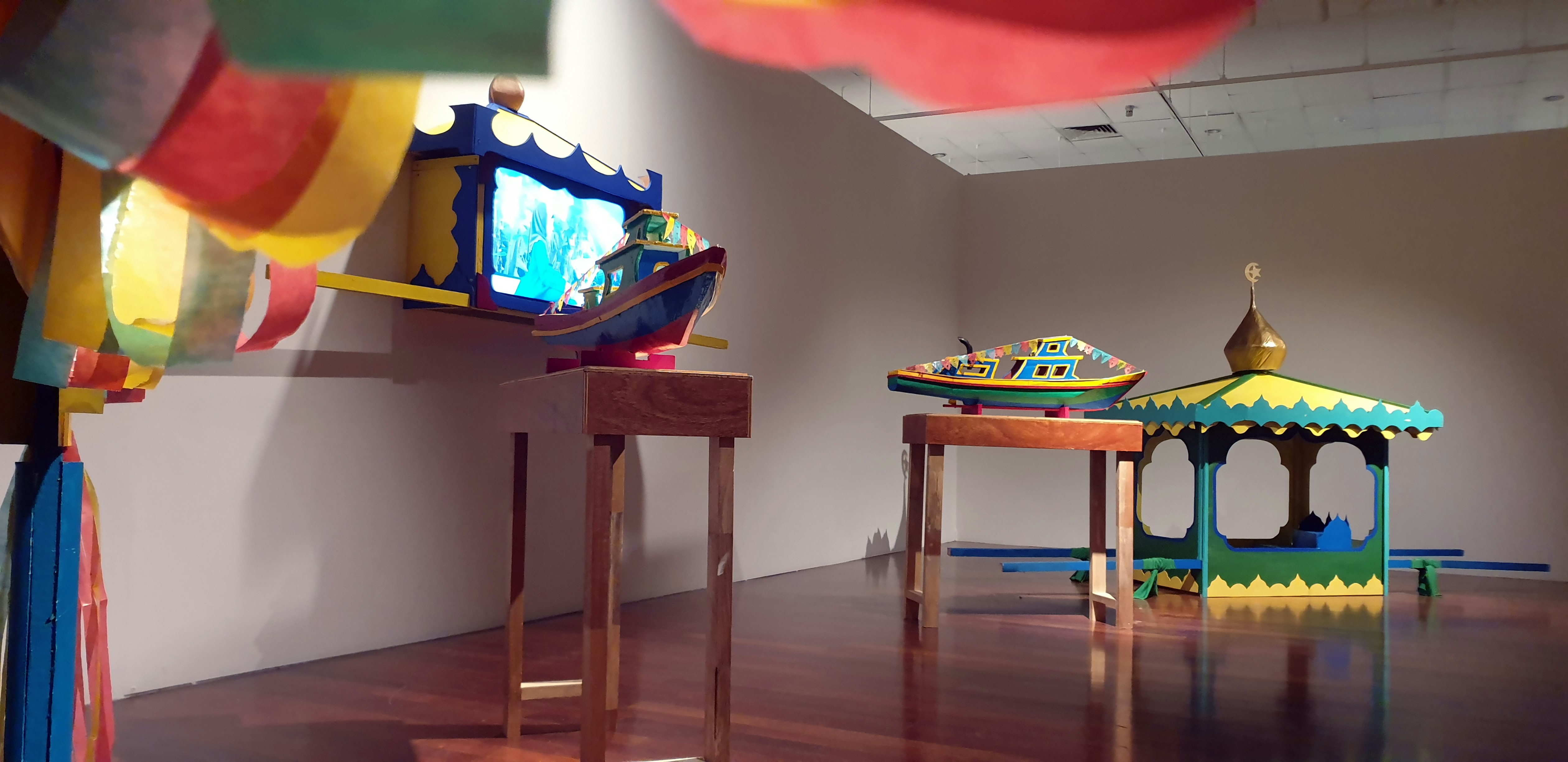
The Parade of the Usungan: and outcome of co-creation project during the Young Contemporary Art Exhibition at National Art Gallery, Malaysia, 2019; image: courtesy Mohamad Faizuan Bin Mat
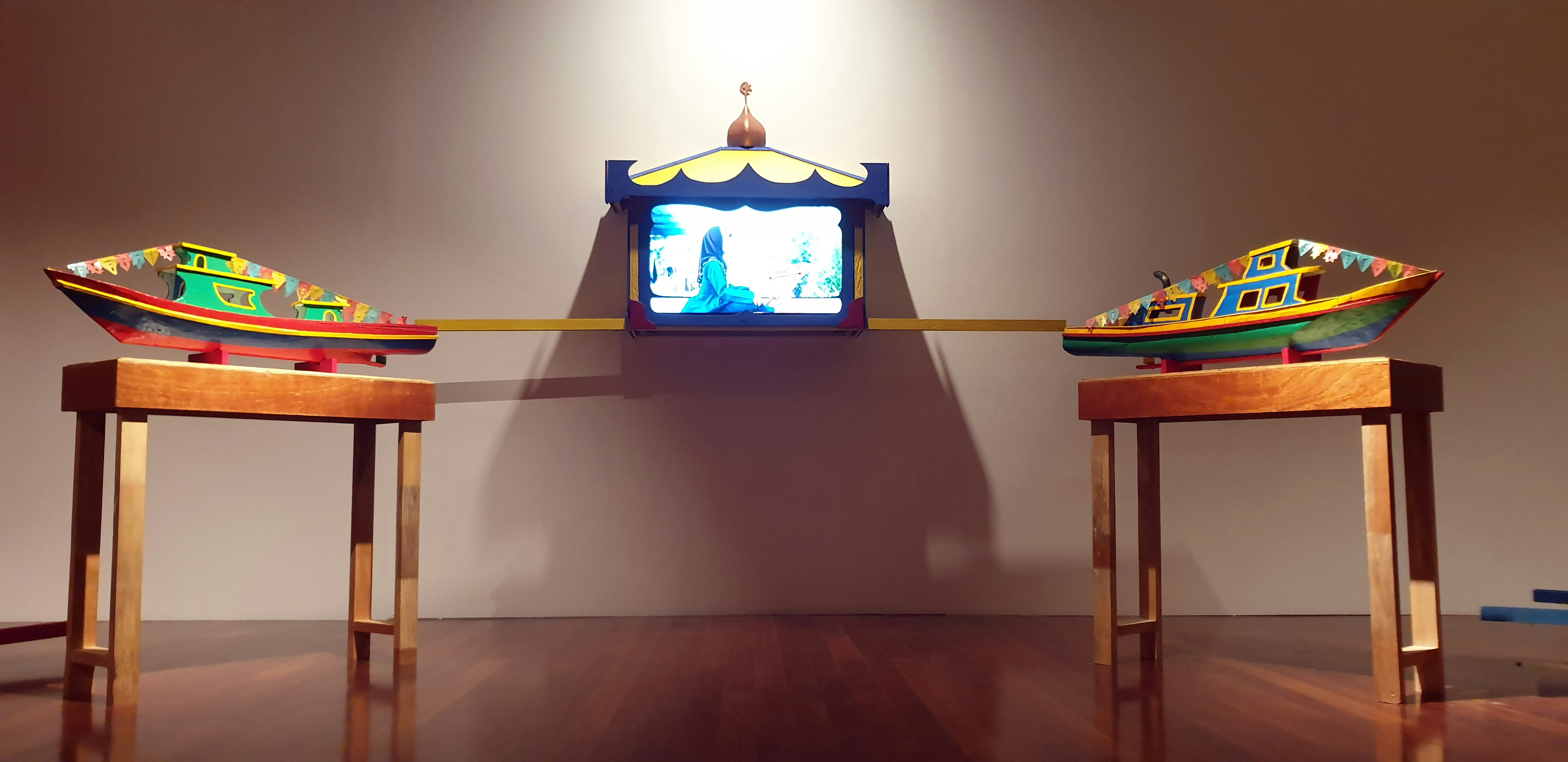
The Parade of the Usungan: and outcome of co-creation project during the Young Contemporary Art Exhibition at National Art Gallery, Malaysia, 2019; image: courtesy Mohamad Faizuan Bin Mat
Some of the findings that we could conclude from the study is that the usungan practice has improved the spirit of togetherness in Sarawak’s coastal community, which continues to remain strong even after so many years. The various usungan designs have demonstrated the creativity and innovative sense that have existed for a long time in the local community. As an artist who grew up with this practice, it has become my social responsibility to find ways to sustain and uphold this tradition. It is to ensure that the practice is continued and valued by future generations. This tradition, culture and the passing down of ancestral processes is unique to Sarawak, and cannot be found in any other parts of Malaysia or other places in the world.
About the contributor
Mohamad Faizuan Bin Mat is a multi-disciplinary artist, curator, writer and lecturer in the Fine Arts Programme, Universiti Malaysia Sarawak.
